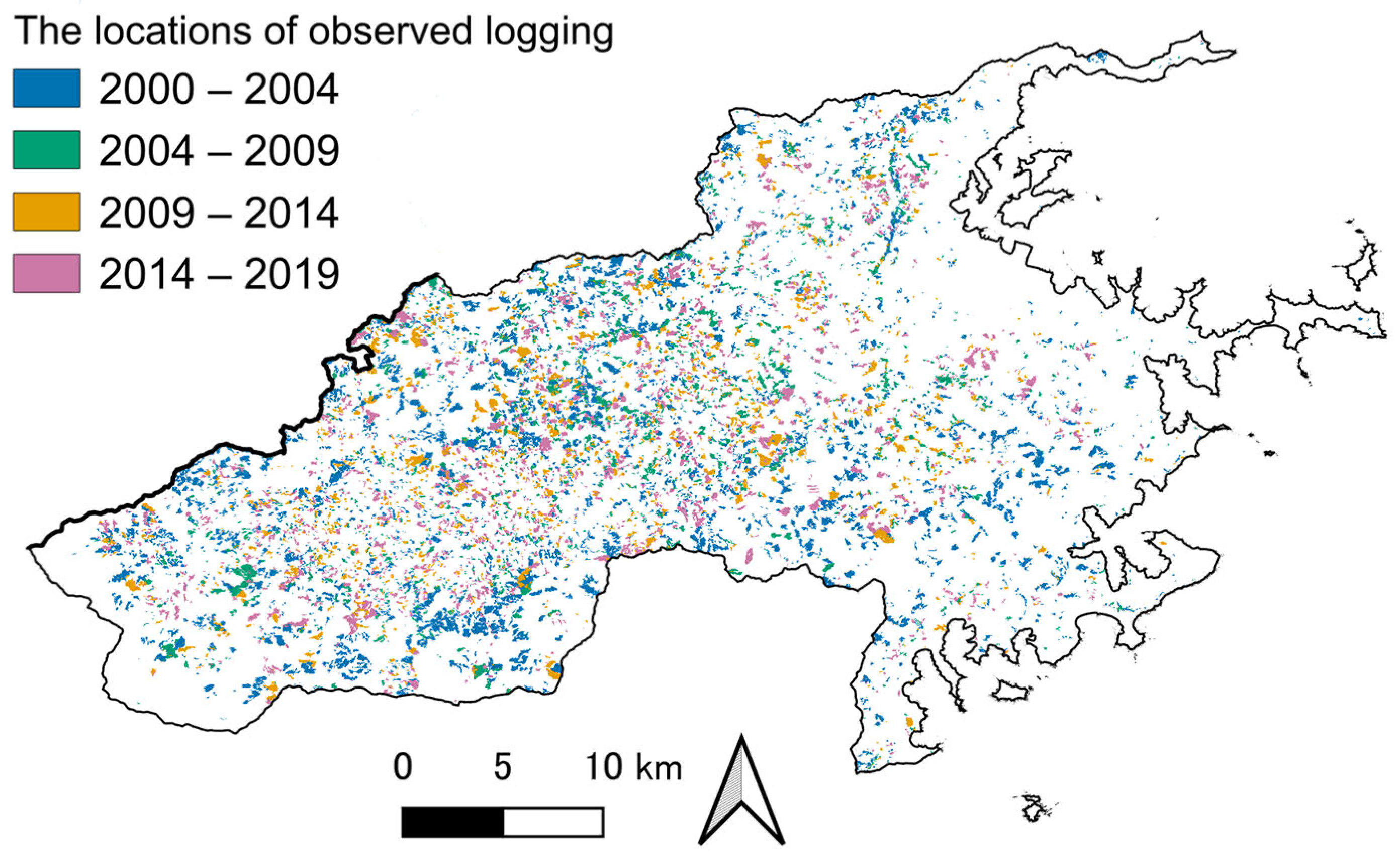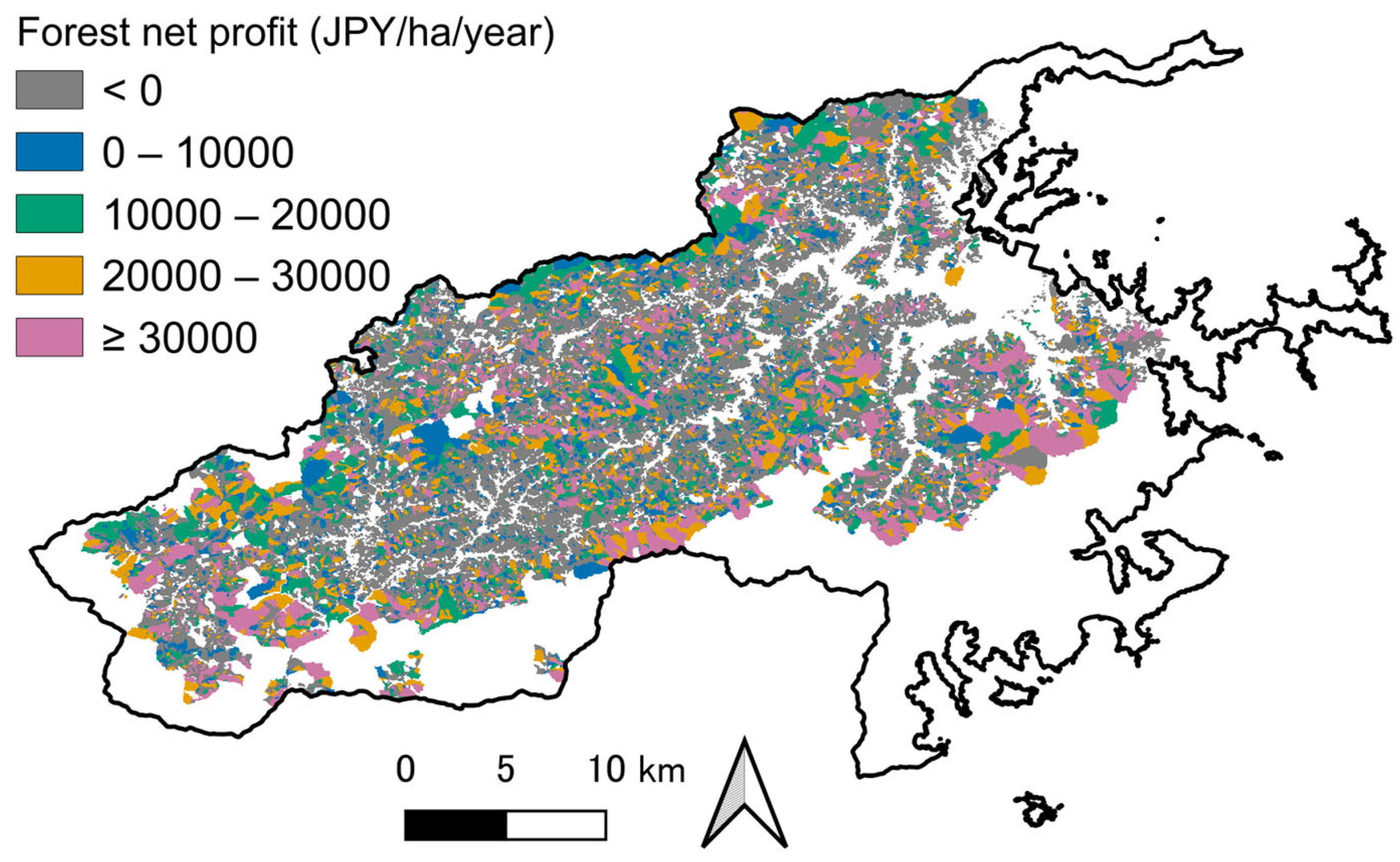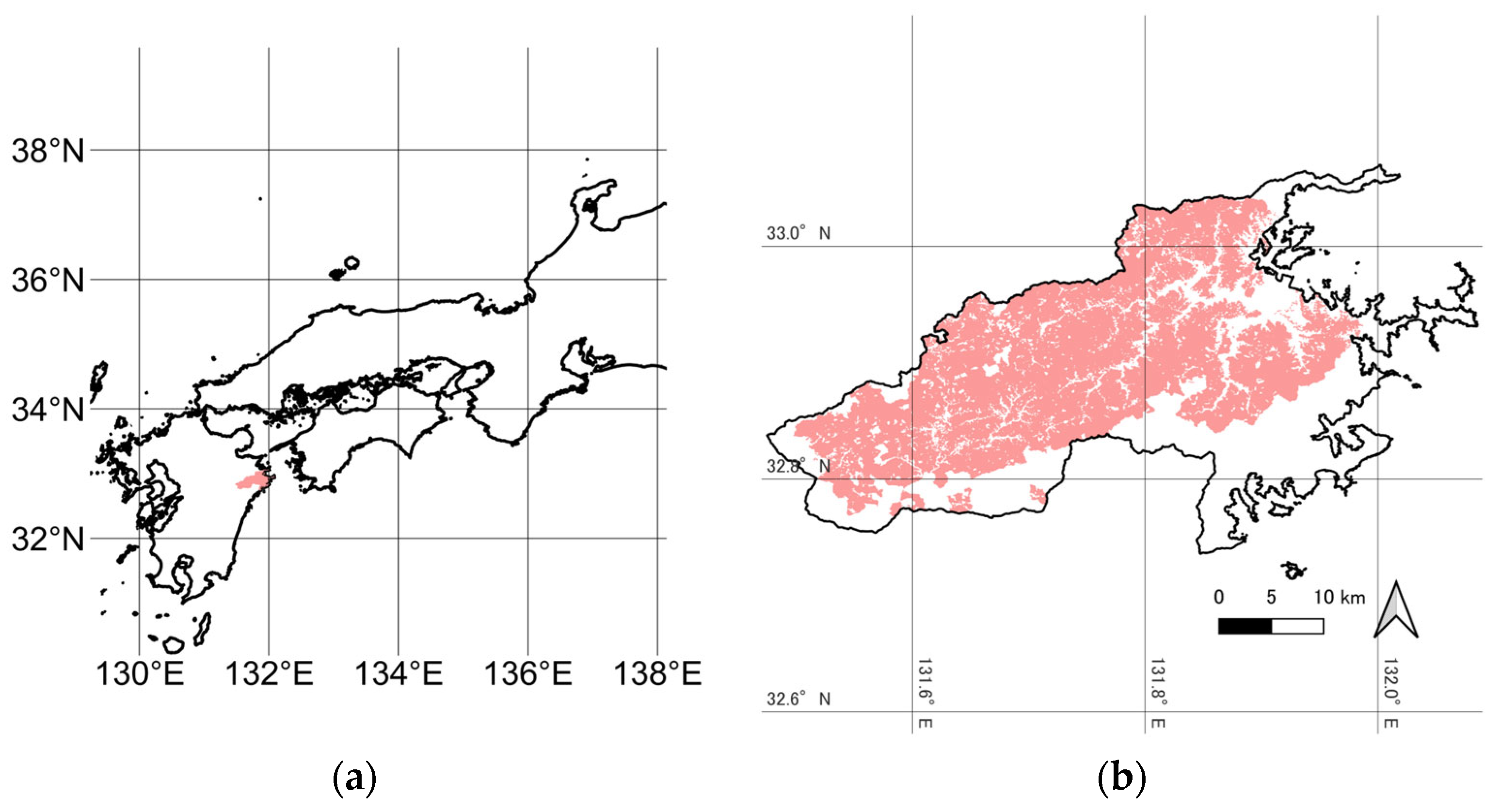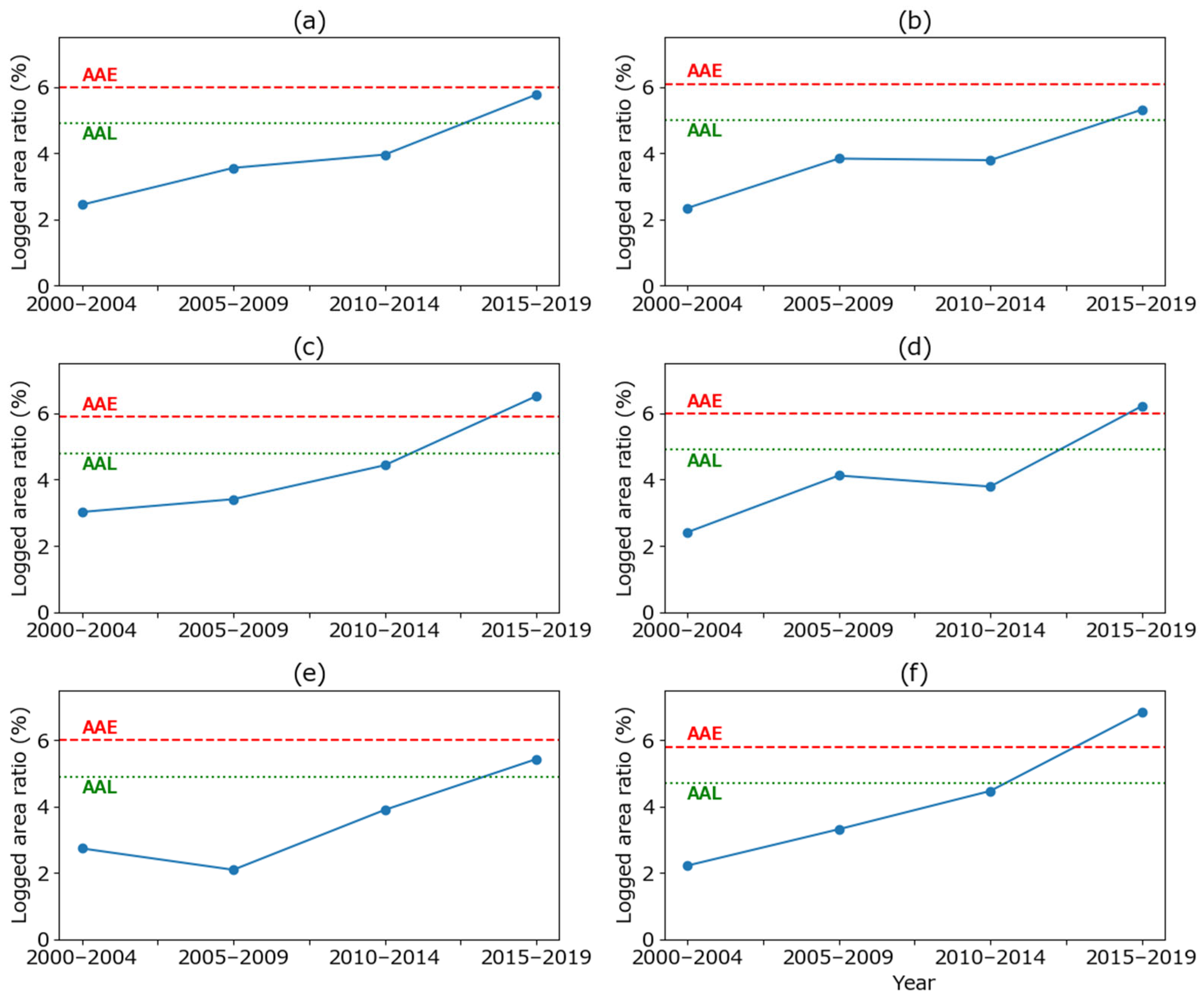Assessing the Sustainability of Timber Production Under Policy-Driven Logging: A Spatial Analysis from Southwestern Japan
Abstract
1. Introduction
2. Materials and Methods
2.1. Study Area
2.2. Logging Locations
2.3. Profitability Analysis
2.4. Landslide Risk Analysis
2.5. Other Areas to Be Excluded
2.6. Sustainability Analysis
3. Results
3.1. Logged Locations
3.2. Profitability Analysis
3.3. Areas Excluded from Sustainability Analysis
3.4. Sustainability Analysis
4. Discussion
5. Conclusions
Author Contributions
Funding
Data Availability Statement
Acknowledgments
Conflicts of Interest
Abbreviations
| ES | Ecosystem service |
| NbS | Nature based solutions |
| AAE | Annual Allowable Logging Area based on Experience |
| AAL | Annual Allowable Logging Area based on Logged Age Distribution |
Appendix A
| Number of initial plantation trees | 2500 trees/ha |
| Thinning ages | 20, 30, 40 years |
| Thinning ratios | 0.4, 0.4, 0.3 |
| Logging age | 50 years |
| Log price | 12,500 JPY/m3 |
| Seedling price | 75 JPY/tree |
| Labor cost | 27,900 JPY/person·day |
| Machinery cost | 50,000 JPY/day |
| Cutting time (C) | N (107.3 e0.0266D + 90.2 e0.0366D) s |
| Yarding time (Y) | s |
| Working days | day |
| Transporting cost | 2500 V JPY |
| Terrain Element | Category | Geological Classification | ||
|---|---|---|---|---|
| Sedimentary | Volcanic | Hypabyssal | ||
| Slope | 0%–30% | 0 | 0 | 0 |
| 31%–50% | 12 | 31 | 23 | |
| 51%–70% | 30 | 61 | 49 | |
| 71%–90% | 42 | 71 | 66 | |
| >91% | 52 | 61 | 57 | |
| Profile curvature | <−0.01 | 22 | 31 | 28 |
| −0.01–+0.01 | 12 | 18 | 17 | |
| >+0.01 | 4 | 16 | 0 | |
| Plan curvature | <150° | 22 | 31 | 28 |
| 150°–210° | 12 | 12 | 15 | |
| >211° | 0 | 0 | 0 | |
| Soil depth | <0.5 m | 0 | 0 | 0 |
| 0.5–1.0 m | 3 | 4 | 4 | |
| 1.0–2.0 m | 7 | 10 | 9 | |
| >2.0 m | 15 | 20 | 19 | |
| Forest age | <5 years | 25 | 35 | 32 |
| 5–15 years | 37 | 51 | 47 | |
| 15–35 years | 28 | 37 | 34 | |
| 35–55 years | 25 | 35 | 32 | |
| >55 years | 22 | 31 | 28 | |


References
- Kalantari, Z.; Ferreira, C.S.S.; Pan, H.; Pereira, P. Nature-Based Solutions to Global Environmental Challenges. Sci. Total Environ. 2023, 880, 163227. [Google Scholar] [CrossRef]
- Seddon, N.; Daniels, E.; Davis, R.; Chausson, A.; Harris, R.; Hou-Jones, X.; Huq, S.; Kapos, V.; Mace, G.M.; Rizvi, A.R.; et al. Global Recognition of the Importance of Nature-Based Solutions to the Impacts of Climate Change. Glob. Sustain. 2020, 3, e15. [Google Scholar] [CrossRef]
- Cohen-Shacham, E.; Andrade, A.; Dalton, J.; Dudley, N.; Jones, M.; Kumar, C.; Maginnis, S.; Maynard, S.; Nelson, C.R.; Renaud, F.G.; et al. Core Principles for Successfully Implementing and Upscaling Nature-Based Solutions. Environ. Sci. Policy 2019, 98, 20–29. [Google Scholar] [CrossRef]
- Brockerhoff, E.G.; Barbaro, L.; Castagneyrol, B.; Forrester, D.I.; Gardiner, B.; González-Olabarria, J.R.; Lyver, P.O.B.; Meurisse, N.; Oxbrough, A.; Taki, H.; et al. Forest Biodiversity, Ecosystem Functioning and the Provision of Ecosystem Services. Biodivers. Conserv. 2017, 26, 3005–3035. [Google Scholar] [CrossRef]
- Harrison, P.A.; Vandewalle, M.; Sykes, M.T.; Berry, P.M.; Bugter, R.; de Bello, F.; Feld, C.K.; Grandin, U.; Harrington, R.; Haslett, J.R.; et al. Identifying and Prioritising Services in European Terrestrial and Freshwater Ecosystems. Biodivers. Conserv. 2010, 19, 2791–2821. [Google Scholar] [CrossRef]
- IPBES. IPBES Global Assessment Report on Biodiversity and Ecosystem Services of the Intergovernmental Science-Policy Platform on Biodiversity and Ecosystem Services; IPBES: Bon, Germany, 2019. [Google Scholar]
- Santika, T.; Wilson, K.A.; Budiharta, S.; Kusworo, A.; Meijaard, E.; Law, E.A.; Friedman, R.; Hutabarat, J.A.; Indrawan, T.P.; St. John, F.A.V.; et al. Heterogeneous Impacts of Community Forestry on Forest Conservation and Poverty Alleviation: Evidence from Indonesia. People Nat. 2019, 1, 204–219. [Google Scholar] [CrossRef]
- Knoke, T.; Messerer, K.; Paul, C. The Role of Economic Diversification in Forest Ecosystem Management. Curr. For. Rep. 2017, 3, 93–106. [Google Scholar] [CrossRef]
- Pohjanmies, T.; Triviño, M.; Le Tortorec, E.; Mazziotta, A.; Snäll, T.; Mönkkönen, M. Impacts of Forestry on Boreal Forests: An Ecosystem Services Perspective. Ambio 2017, 46, 743–755. [Google Scholar] [CrossRef]
- Gauthier, S.; Bernier, P.; Kuuluvainen, T.; Shvidenko, A.Z.; Schepaschenko, D.G. Boreal Forest Health and Global Change. Science 2015, 349, 819–822. [Google Scholar] [CrossRef]
- Japan Forestry Agency. The Basic Plan on Forest and Forestry; Japan Forestry Agency: Tokyo, Japan, 2021.
- Japan Forestry Agency. Annual Report on Forest and Forestry in Japan (Fiscal Year 2023); Japan Forestry Agency: Tokyo, Japan, 2023.
- Börner, J.; Schulz, D.; Wunder, S.; Pfaff, A. The Effectiveness of Forest Conservation Policies and Programs. Annu. Rev. Resour. Econ. 2020, 12, 45–64. [Google Scholar] [CrossRef]
- Macpherson, E.; Mortiaux, R.; Jorgensen, E. Scale-Sensitive Marine Law and Policy Design: Towards Ecosystem-Based Management across Spatial and Temporal Scales. Wiley Interdiscip. Rev. Energy. Environ. 2024, 13, e537. [Google Scholar] [CrossRef]
- Jensen, T.; Lussier, J.M. Economic Impacts of Partial Harvesting: Mitigating Mid-Term Timber Supply Shortages as a Result of Pest Outbreaks. For. Chron. 2021, 97, 271–276. [Google Scholar] [CrossRef]
- Olschewski, R.; Klein, A.M.; Tscharntke, T. Economic Trade-Offs between Carbon Sequestration, Timber Production, and Crop Pollination in Tropical Forested Landscapes. Ecol. Complex. 2010, 7, 314–319. [Google Scholar] [CrossRef]
- Carpentier, S.; Filotas, E.; Handa, I.T.; Messier, C. Trade-Offs between Timber Production, Carbon Stocking and Habitat Quality When Managing Woodlots for Multiple Ecosystem Services. Environ. Conserv. 2017, 44, 14–23. [Google Scholar] [CrossRef]
- Jucker, T.; Bouriaud, O.; Avacaritei, D.; Coomes, D.A. Stabilizing Effects of Diversity on Aboveground Wood Production in Forest Ecosystems: Linking Patterns and Processes. Ecol. Lett. 2014, 17, 1560–1569. [Google Scholar] [CrossRef]
- Noviandi, R.; Gomi, T.; Pratama, M.; Ritonga, R.P.; Fathani, T.F.; Maylda Pratama, G. Understanding the Role of Vegetation Root Systems in the Initiation of Rainfall-Induced Shallow Landslides: Scaling Perspectives. J. For. Res. 2025, 30, 165–178. [Google Scholar] [CrossRef]
- WWF. Global Roadmap for a Nature-Positive Economy an Economic and Financial Reform Agenda to Meet Narure and Climate Goals; WWF: Gland, Switzerland, 2024. [Google Scholar]
- Yamaura, Y.; Yamada, Y.; Matsuura, T.; Tamai, K.; Taki, H.; Sato, T.; Hashimoto, S.; Murakami, W.; Toda, K.; Saito, H.; et al. Modeling Impacts of Broad-Scale Plantation Forestry on Ecosystem Services in the Past 60 Years and for the Future. Ecosyst. Serv. 2021, 49, 101271. [Google Scholar] [CrossRef]
- Polyakov, M.; Wear, D.N.; Huggett, R.N. Harvest Choice and Timber Supply Models for Forest Forecasting. For. Sci. 2010, 56, 344–355. [Google Scholar] [CrossRef]
- Prestemon, J.P.; Wear, D.N. Linking Harvest Choices to Timber Supply. For. Sci. 2000, 46, 377–389. [Google Scholar] [CrossRef]
- Yamada, Y.; Fukumoto, K. Spatial Relationships between Annual Timber Productions and Logging Locations in the Prefectures of Kyushu Island. J. Jpn. For. Soc. 2023, 105, 259–263. [Google Scholar] [CrossRef]
- Yamada, Y.; Yamaura, Y.; Shimizu, K.; Murakami, W.; Nanko, K.; Takayama, N. Conflicts among Ecosystem Services May Depend on Environmental Awareness: A Multi-Municipality Analysis. Forestry 2024, 97, 424–435. [Google Scholar] [CrossRef]
- Dataset: Country-Wide Mapping of Harvest Areas and Post-Harvest Forest Recovery Using Landsat Time Series Data in Japan. Available online: https://zenodo.org/records/11634214 (accessed on 22 February 2023).
- Shimizu, K.; Saito, H. Country-Wide Mapping of Harvest Areas and Post-Harvest Forest Recovery Using Landsat Time Series Data in Japan. Int. J. Appl. Earth Obs. Geoinf. 2021, 104, 102555. [Google Scholar] [CrossRef]
- Gorelick, N.; Hancher, M.; Dixon, M.; Ilyushchenko, S.; Thau, D.; Moore, R. Google Earth Engine: Planetary-Scale Geospatial Analysis for Everyone. Remote Sens. Environ. 2017, 202, 18–27. [Google Scholar] [CrossRef]
- Japan Forestry Agency. Procedures for Harvest Forecasts Using Forest Stand Density Control Diagram; Japan Forestry Agency: Tokyo, Japan, 2024.
- Nishizono, T.; Inoue, A.; Hosoda, K. Relationship between Relative Yield Index and Relative Spacing Index: Theoretical Derivation of the Relationship and Its Characteristics. J. Jpn. For. Plann. 2013, 47, 16–28. [Google Scholar] [CrossRef]
- Oka, M. Studies on the Analysis and Evaluation on Mechanized Yarding. Ph.D. Thesis, University of Tokyo, Tokyo, Japan, 2006. [Google Scholar]
- Saito, H.; Murakami, W.; Daimaru, H.; Oguchi, T. Effect of Forest Clear-Cutting on Landslide Occurrences: Analysis of Rainfall Thresholds at Mt. Ichifusa, Japan. Geomorphology 2017, 276, 1–7. [Google Scholar] [CrossRef]
- Shuin, Y.; Turumi, K.; Matsue, K.; Aruga, K.; Tasaka, T. Evaluation of Soil Reinforcement by Tree Root System Using a Distributed Shallow Landslides Model. J. Jpn. Soc. Reveget. Technol. 2009, 35, 9–14. [Google Scholar] [CrossRef]
- MAFF. Investigation Method of the Disaster Risk District in the Mountain; MAFF: Tokyo, Japan, 2016.
- Shuin, Y.; Hotta, N.; Matsue, K.; Aruga, K.; Tasaka, T. Simulating Effects of Spatial Distribution of Different Stand Age of Hinoki Cypress on the Location of Shallow Landslides. J. Jpn. Soc. Reveget. Technol. 2011, 37, 102–107. [Google Scholar] [CrossRef][Green Version]
- Heinonen, T.; Pukkala, T.; Asikainen, A. Variation in Forest Landowners’ Management Preferences Reduces Timber Supply from Finnish Forests. Ann. For. Sci. 2020, 77, 31. [Google Scholar] [CrossRef]
- Onda, N.; Ochi, S.; Tsuzuki, N. Examination of Social Factors Affecting Private Forest Owners’ Future Intentions for Forest Management in Miyazaki Prefecture: A Comparison of Regional Characteristics by Forest Ownership Size. Forests 2023, 14, 309. [Google Scholar] [CrossRef]
- Yoshihara, S. Realities and Challenges of Land Issues in the Era of Depopulation. Jpn. J. Real. Estate Sci. 2017, 31, 79–83. [Google Scholar] [CrossRef]
- The Ministry of Land Infrastructure Transport and Tourism of Japan. Special Measures Law for Facilitating the Use of Land with Unknown Owners; The Ministry of Land Infrastructure Transport and Tourism of Japan: Tokyo, Japan, 2019.
- Demarais, S.; Verschuyl, J.P.; Roloff, G.J.; Miller, D.A.; Wigley, T.B. Tamm Review: Terrestrial Vertebrate Biodiversity and Intensive Forest Management in the U.S. For. Ecol. Manag. 2017, 385, 308–330. [Google Scholar] [CrossRef]
- Benra, F.; Nahuelhual, L.; Gaglio, M.; Gissi, E.; Aguayo, M.; Jullian, C.; Bonn, A. Ecosystem Services Tradeoffs Arising from Non-Native Tree Plantation Expansion in Southern Chile. Landsc. Urban. Plan. 2019, 190, 103589. [Google Scholar] [CrossRef]
- Blattert, C.; Eyvindson, K.; Hartikainen, M.; Burgas, D.; Potterf, M.; Lukkarinen, J.; Snäll, T.; Toraño-Caicoya, A.; Mönkkönen, M. Sectoral Policies Cause Incoherence in Forest Management and Ecosystem Service Provisioning. For. Policy. Econ. 2022, 136, 102689. [Google Scholar] [CrossRef]
- Levers, C.; Verkerk, P.J.; Müller, D.; Verburg, P.H.; Butsic, V.; Leitão, P.J.; Lindner, M.; Kuemmerle, T. Drivers of Forest Harvesting Intensity Patterns in Europe. For. Ecol. Manag. 2014, 315, 160–172. [Google Scholar] [CrossRef]
- Poje, A.; Pezdevšek Malovrh, Š.; Krč, J. Factors Affecting Harvesting Intensity in Small-Scale Private Forests in Slovenia. Small-scale For. 2016, 15, 73–91. [Google Scholar] [CrossRef]
- Bennett, E.M.; Peterson, G.D.; Gordon, L.J. Understanding Relationships among Multiple Ecosystem Services. Ecol. Lett. 2009, 12, 1394–1404. [Google Scholar] [CrossRef] [PubMed]
- Temperli, C.; Blattert, C.; Stadelmann, G.; Brändli, U.B.; Thürig, E. Trade-Offs between Ecosystem Service Provision and the Predisposition to Disturbances: A NFI-Based Scenario Analysis. For. Ecosyst. 2020, 7, 27. [Google Scholar] [CrossRef]
- Frizzle, C.; Fournier, R.A.; Trudel, M.; Luther, J.E. Towards Sustainable Forestry: Using a Spatial Bayesian Belief Network to Quantify Trade-Offs among Forest-Related Ecosystem Services. J. Environ. Manag. 2022, 301, 113817. [Google Scholar] [CrossRef]
- Leiter, M.; Neumann, M.; Egusa, T.; Harashina, K.; Hasenauer, H. Assessing the Resource Potential of Mountainous Forests: A Comparison between Austria and Japan. Forests 2022, 13, 891. [Google Scholar] [CrossRef]
- Ficko, A. Private Forest Owners’ Social Economic Profiles Weakly Influence Forest Management Conceptualizations. Forests 2019, 10, 956. [Google Scholar] [CrossRef]
- Palomo, I.; Locatelli, B.; Otero, I.; Colloff, M.; Crouzat, E.; Cuni-Sanchez, A.; Gómez-Baggethun, E.; González-García, A.; Grêt-Regamey, A.; Jiménez-Aceituno, A.; et al. Assessing Nature-Based Solutions for Transformative Change. One Earth 2021, 4, 730–741. [Google Scholar] [CrossRef]
- Bowe, S.A.; Ballweg, J.M.; Blinn, C.R.; Nolle, D.A.; Smail, R.A. The Logging Sector in Minnesota and Wisconsin: Status, Issues, and Challenges in 2021. J. For. 2025, 123, 41–62. [Google Scholar] [CrossRef]
- Zhang, J.; Alavalapati, J.R.R.; Shrestha, R.K.; Hodges, A.W. Economic Impacts of Closing National Forests for Commercial Timber Production in Florida and Liberty County. J. For. Econ. 2005, 10, 207–223. [Google Scholar] [CrossRef]
- Alounsavath Master, P.; Kim, S. Bin Economic Feasibility of a Sustainable Production Forest Management System in Xaibouathong Forest Management Area, Khammouan Province, Lao PDR. Forest Sci. Technol. 2021, 17, 119–124. [Google Scholar] [CrossRef]
- Macpherson, A.J.; Carter, D.R.; Schulze, M.D.; Vidal, E.; Lentini, M.W. The Sustainability of Timber Production from Eastern Amazonian Forests. Land Use Policy 2012, 29, 339–350. [Google Scholar] [CrossRef]
- Deitch, M.J.; Gancel, H.N.; Croteau, A.C.; Caffrey, J.M.; Scheffel, W.; Underwood, B.; Muller, J.W.; Boudreau, D.; Cantrell, C.G.; Posner, M.J.; et al. Adaptive Management as a Foundational Framework for Developing Collaborative Estuary Management Programs. J. Environ. Manag. 2021, 295, 113107. [Google Scholar] [CrossRef]
- Reed, M.S. Stakeholder Participation for Environmental Management: A Literature Review. Biol. Conserv. 2008, 141, 2417–2431. [Google Scholar] [CrossRef]
- Rico, M.; González, A. Social Participation into Regional Forest Planning Attending to Multifunctional Objectives. For. Policy Econ. 2015, 59, 27–34. [Google Scholar] [CrossRef]
- Maxwell, C.J.; Scheller, R.M.; Wilson, K.N.; Manley, P.N. Assessing the Effectiveness of Landscape-Scale Forest Adaptation Actions to Improve Resilience under Projected Climate Change. Front. For. Glob. Change 2022, 5, 740869. [Google Scholar] [CrossRef]
- Miranda, K.M.; Parry, I.W.H.; Gupta, S. Public Expenditure Policy and the Environment: A Review and Synthesis. IMF Work. Pap. 1993, 93, 42. [Google Scholar] [CrossRef]



| Forest Net Income (JPY) | |||||
|---|---|---|---|---|---|
| <0 | 0–10,000 | 10,000–20,000 | 20,000–30,000 | 30,000≤ | |
| High-risk of landslide | 14.8% | 17.4% | 15.8% | 16.3% | 19.6% |
| Unclear ownership | 28.2% | ||||
| Timber producing area | 61.2% | 59.3% | 60.5% | 60.1% | 57.7% |
| AAE (5 years) | 6.1% | 5.9% | 6.0% | 6.0% | 5.8% |
| AAL (5 years) | 5.0% | 4.8% | 4.9% | 4.9% | 4.7% |
Disclaimer/Publisher’s Note: The statements, opinions and data contained in all publications are solely those of the individual author(s) and contributor(s) and not of MDPI and/or the editor(s). MDPI and/or the editor(s) disclaim responsibility for any injury to people or property resulting from any ideas, methods, instructions or products referred to in the content. |
© 2025 by the authors. Licensee MDPI, Basel, Switzerland. This article is an open access article distributed under the terms and conditions of the Creative Commons Attribution (CC BY) license (https://creativecommons.org/licenses/by/4.0/).
Share and Cite
Yamada, Y.; Kanomata, H.; Shimizu, K.; Murakami, W.; Yamaura, Y. Assessing the Sustainability of Timber Production Under Policy-Driven Logging: A Spatial Analysis from Southwestern Japan. Forests 2025, 16, 989. https://doi.org/10.3390/f16060989
Yamada Y, Kanomata H, Shimizu K, Murakami W, Yamaura Y. Assessing the Sustainability of Timber Production Under Policy-Driven Logging: A Spatial Analysis from Southwestern Japan. Forests. 2025; 16(6):989. https://doi.org/10.3390/f16060989
Chicago/Turabian StyleYamada, Yusuke, Hidesato Kanomata, Katsuto Shimizu, Wataru Murakami, and Yuichi Yamaura. 2025. "Assessing the Sustainability of Timber Production Under Policy-Driven Logging: A Spatial Analysis from Southwestern Japan" Forests 16, no. 6: 989. https://doi.org/10.3390/f16060989
APA StyleYamada, Y., Kanomata, H., Shimizu, K., Murakami, W., & Yamaura, Y. (2025). Assessing the Sustainability of Timber Production Under Policy-Driven Logging: A Spatial Analysis from Southwestern Japan. Forests, 16(6), 989. https://doi.org/10.3390/f16060989









